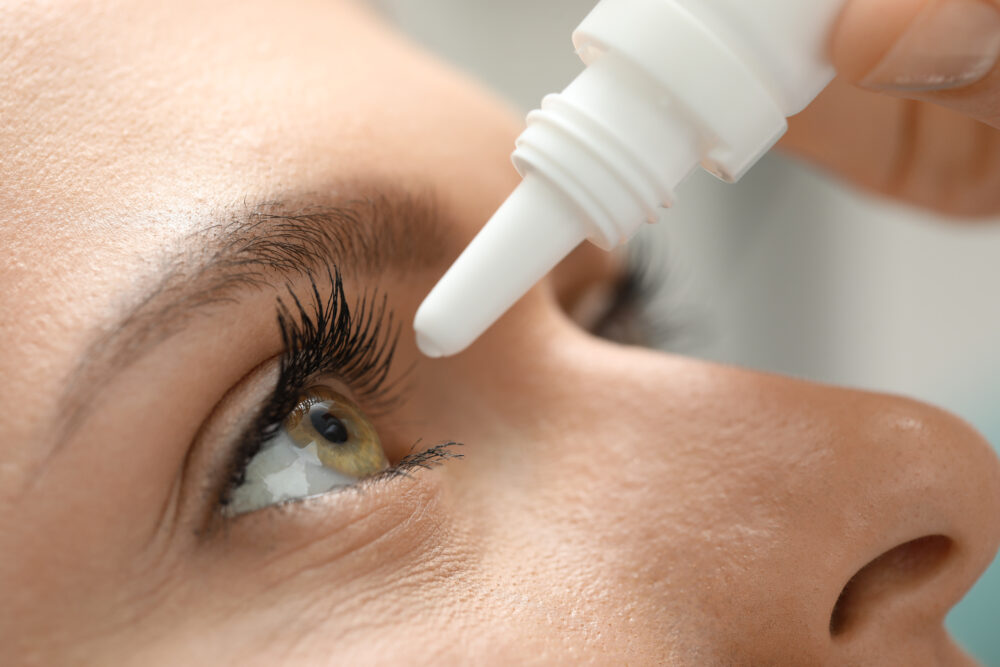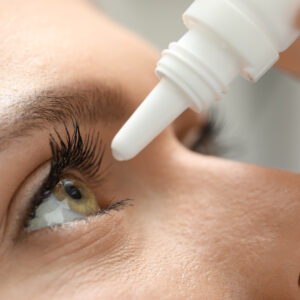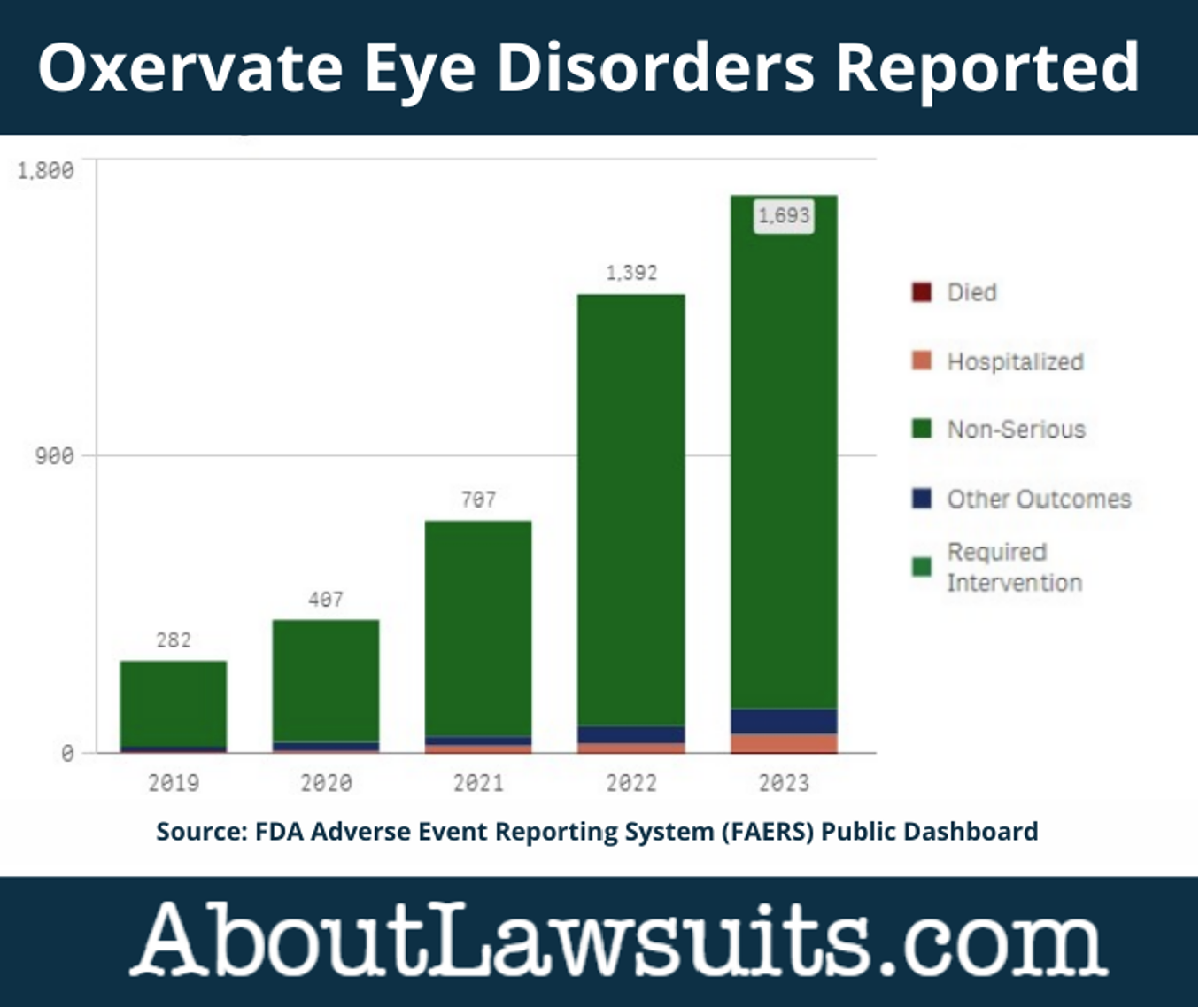
Oxervate Lawsuit
UPDATES AND LAWSUIT INFORMATION
A growing body of medical research and case reports have linked Oxervate eye drops to an increased risk of corneal plaques and ulcers that can lead to permanent vision loss and other side effects.
Lawyers are investigating Oxervate vision loss lawsuits for those individuals who were prescribed Oxervate eye drops and developed vision loss, required surgery to repair or replace the corneal and other side effects that were not disclosed by the drug manufacturer.
Individuals who used Oxervate eye drops and experienced any of the following may entitled to financial compensation;
- Blindness
- Blurred vision
- Sensitivity to light (Photophobia)
- Corneal ulcer
- Corneal deposits
- Contact lens deposits
- Severe pain and swelling
- Corneal transplant surgery (Keratoplasty)
- Received an artificial cornea (Keratoprosthesis)
- Other side effects or eye disorders caused by Oxervate
Oxervate Vision Loss Lawsuit Overview
While there have not yet been any Oxervate vision loss lawsuits filed to date, product liability lawyers across the U.S. are actively investigating potential claims against Dompé, the drug’s manufacturer, for potentially failing to warn about the risks of corneal ulcers and deposits that can lead to vision loss and other eye disorders.
The drug cenegermin Bkbj, sold under the brand name Oxervate, belongs to a class of medications known as nerve growth factors, which are proteins that play a crucial role in the growth, maintenance, and survival of nerve cells, including those in the eyes. Oxervate works by enhancing the survival and growth of corneal nerves and cells to promote healing and restore corneal health.
Oxervate prescription eye drops, manufactured by Dompé, were granted orphan drug status by the U.S. Food and Drug Administration (FDA) in 2015. This designation accelerates the review process and typically requires less comprehensive clinical data for treatments targeting rare diseases.
The FDA first approved Oxervate for use in 2018, as the first approved treatment for neurotrophic keratitis, a rare and degenerative corneal disease. This approval was based on a limited set of clinical data that showed the drug’s efficacy in repairing the corneal surface.
While clinical trials for the drugs approval showed that a percentage of patients treated with Oxervate experienced complete corneal healing compared to those who received a placebo, up to 10% of Oxervate participants experienced corneal deposits, which are buildups of material on the cornea that can lead to vision threatening side effects.
Since the drug’s release, thousands of users have reported experiencing eye disorders after using Oxervate, including blindness, blurred vision, sensitivity to light, foreign body sensation in the eyes and other eye disorders.
Lawyers are actively investigating these claims, focusing on whether Dompé’s failed to warn users of known eye disorders associated with Oxervate. If it is found that the manufacturer was indeed aware of the risks and chose not to fully disclose them, individuals impacted by these side effects may be entitled to financial compensation for the harm suffered.
Who May be Eligible for an Oxervate Lawsuit?
Financial benefits may be available through an Oxervate lawsuit settlement for individuals who used Oxervate eye drops, and experienced any of the following side effects;
- Vision loss
- Blurred vision
- Light sensitivity
- Corneal scarring
- Corneal deposits
- Contact lens deposits
- Severe eye pain and swelling
- Eyelid inflammation
- Corneal transplant surgery
- Artificial cornea surgery
- Other Oxervate side effects

Do You Have A Case?
Oxervate Lawsuit
Lawyers are reviewing Oxervate lawsuits for individuals who have developed corneal side effects or vision loss. See if you qualify for a claim.
SEE IF YOU QUALIFY FOR COMPENSATIONInfo About Oxervate Lawsuits On This Page
Oxervate Vision Side Effects
According to the FDA’s Adverse Event Reporting System (FAERS), roughly 6,497 adverse events have been reported to the FDA since 2019, with 4,461 of these Oxervate adverse reactions being categorized as eye disorders.
Some of the most commonly reported Oxervate vision problems have included;
- Photophobia
- Vision Blurred
- Foreign Body Sensation In Eyes
- Visual Impairment
- Corneal Deposits
- Eye Disorder
- Eye Ulcer
- Corneal Neovascularisation
- Corneal Scar
- Corneal Thinning
- Corneal Erosion

Oxervate Corneal Deposits and Corneal Ulcer Side Effects
Medical research and FDA-reported adverse events indicate that individuals using Oxervate eye drops may be at risk of developing corneal ulcers and corneal deposits, which may require medical intervention to prevent vision loss side effects.
How Does Oxervate Cause Corneal Deposits?
The protein in Oxervate, cenegermin, can sometimes precipitate out in the eye, especially when the local environment within the eye changes (e.g., pH changes or interaction with other ions or molecules in the tear film). These precipitates form what are known as corneal deposits.
These deposits are essentially clusters of protein that settle on the cornea, which can cause visual disturbances and discomfort. They generally appear as small, opaque or translucent spots on the cornea that might affect vision if they are extensive or located in the central visual axis.
Symptoms of Corneal Deposits: Corneal deposits, while generally less severe than ulcers, can still cause discomfort and affect vision. Symptoms include:
- Visual Disturbances: Deposits can scatter the light entering the eye, leading to blurred or clouded vision.
- Visible Spots: These deposits often appear as white or grayish spots on the cornea, visible to an examining eye care professional and sometimes even noticeable by the patient in their field of vision.
- Slight Discomfort: While not as painful as ulcers, deposits can cause a foreign body sensation in the eye, as if something is in the eye that shouldn’t be.
Can Oxervate Cause Corneal Ulcers?
While the mechanism of action in which Oxervate may cause corneal ulcers is currently still being investigated, medical research has suggested that these corneal ulcers may occur due to allergic reactions to cenegermin, which may lead to severe inflammation and disruption of the corneal surface and the corneal epithelium (the outermost layer of the cornea).
Once the epithelial barrier is compromised, the underlying corneal tissue becomes more susceptible to infections, potentially leading to ulcers.
Symptoms of Corneal Ulcers: Corneal ulcers are serious and can lead to rapid deterioration of eye health if not treated promptly. The symptoms include:
- Severe Pain: The cornea is richly innervated by nerves, making any injury to it, such as an ulcer, typically very painful.
- Redness: The area around the ulcer often becomes red due to inflammation and irritation.
- Blurred Vision: As ulcers can affect the smoothness and clarity of the cornea, vision may become blurry.
- Sensitivity to Light (Photophobia): This symptom occurs because the inflamed eye becomes hypersensitive to light, making bright environments uncomfortable.
- Watery Eyes: The eye may produce excess tears in response to the irritation or as a reflex to the discomfort.
- Pus or Discharge: An infectious ulcer may produce a thick discharge, which can be yellow or greenish in color, indicating the presence of pus.
- White or Gray Spot on the Cornea: Visible on the cornea, this spot is where the ulcer is located and can sometimes be seen with the naked eye, depending on the ulcer’s size and depth.
Oxervate-Induced Corneal Transplant Surgery
Outlined in the FDA’s adverse events reported from Oxervate users, at least 45 individuals using the prescription eye drops required a corneal transplant surgery.
When complications from Oxervate treatment lead to significant corneal damage, such as severe corneal deposits or ulcers, surgical interventions including keratoplasty and keratoprosthesis may be necessary to restore vision and maintain the structural integrity of the eye.
Keratoplasty
Keratoplasty surgery involves replacing damaged or diseased corneal tissue with healthy donor corneal tissue. It can be performed as a full-thickness transplant (penetrating keratoplasty) or as a partial-thickness transplant (lamellar keratoplasty), depending on the extent and depth of the corneal damage.
A Keratoplasty procedure is often considered when corneal ulcers lead to deep scarring that significantly impairs vision or when ulcers are unresponsive to medical treatment and risk perforating the cornea. It may also be necessary if extensive corneal deposits distort vision and cannot be managed with less invasive treatments.
Keratoprosthesis
Keratoprosthesis surgery involves the implantation of an artificial cornea. It is an option primarily for patients who are not good candidates for traditional corneal transplantation or have had multiple failed corneal transplants.
A Keratoprosthesis procedure is generally reserved for severe cases, such as when corneal tissue is extensively damaged or diseased, making it unlikely to support a natural donor graft. This may occur in severe cases of recurrent corneal ulcers that have led to multiple scars, infections, or in cases where the structural integrity of the cornea is compromised.

SHARE YOUR STORY
Did you or a loved one develop eye injuries or vision loss after using Oxervate? Share your story with AboutLawsuits.com and have your comments reviewed by a lawyer to determine if you may be eligible for a lawsuit.
Studies Linking Oxervate to Corneal Deposits and Corneal Ulcers
In additional to the growing number of eye disorder and vision from linked to Oxervate being reported to the FDA, a growing body of medical research has raised concerns over Oxervate corneal deposit and ulcer side effects being reported by users.
Oxervate Vision Impairment From Calcium Deposits
In a case series published in the medical journal Cornea in January 2022, researchers found that five patients across three medical facilities with stage 2 or 3 neurotrophic keratitis (NK) developed a rapid onset of corneal opacity that were consistent with calcium deposits after being treated with Oxervate.
Researchers stated that in each case, the individuals developed “visually significant” corneal deposits within a few weeks of starting Oxervate, which did not resolve after stopping the eye drops.
According to the outcomes, the study indicated one patient was effectively treated by removing the outer layers of the cornea and using a chemical treatment to clear the calcium deposits. Another patient underwent a complete corneal transplant, and a third received an artificial cornea implant known as a Boston keratoprosthesis.
Oxervate Label Missing Corneal Deposit Side Effects
In a study published in the peer-reviewed medical journal Expert Opinion on Drug Safety, researchers looked at 3,288 cases of Oxervate side effects reported from 2018 through 2022, finding 50 occular-related events that researchers say are not disclosed on the manufacturers Oxervate safety label.
The study found that 20 of the adverse events involved;
- Corneal perforation
- Corneal deposits
- Eye infection, and
- Eye inflammation
Researchers stated;
“The safety information on the label is incomplete, and the adverse reactions noted are mostly mild and tolerable. However, the occurrence of painful epithelial plagues and irreversible corneal deposits after cenegermin usage have been reported.”
Oxervate Deposit Formation During Contact Lens Use
In a case report published in the American Journal of Ophthalmology in May 2022, researchers indicated that over an eight-week treatment with Oxervate, a patient with stage III neurotrophic keratitis experienced significant build-up of deposits on her eye’s surface and on her bandage contact lens (BCL).
Researchers stated the deposits on the eye were loosely attached and cleared quickly once the BCL was removed, but they formed again quickly and consistently each time the BCL was replaced, across five different exchanges.
The deposits formed repeatedly and rapidly every time the BCL was exchanged, supports the link between Oxervate and ocular surface deposits.
Corneal Plaque Formation After Oxervate Use
In a study published in the the medical journal Cornea on November 2023, researchers highlighted a case report of a 72-year-old man who experienced a corneal superficial plaque formation following treatment with the human nerve growth factor drug Oxervate.
After starting use of Oxervate, researchers stated his epithelial defect healed successfully. However, 22 days post-treatment, a white, thick, and adherent corneal plaque developed unexpectedly and required surgical removal.
Oxervate Vision Loss Side Effects
The FDA has become aware of more than 160 reports of Oxervate users suffering from various degrees of degrees of visual impairment or total blindness.
Corneal ulcers and corneal deposits resulting from the use of Oxervate can both permanently impair vision, ranging from mild blurring to total blindness, depending on the extent and location of the ulcers or deposits.
Corneal Ulcer Vision Loss
- Infection and Inflammation: Corneal ulcers are typically due to an infection that causes inflammation. The infection disrupts the cornea’s clear structure, leading to cloudiness or opaqueness which can obstruct vision.
- Scarring: After an ulcer heals, it often leaves behind a scar. Depending on the location and size of the scar, it can significantly impair vision by blocking or distorting light as it enters the eye.
- Perforation: In severe cases, an ulcer can progress to perforate the cornea, creating a direct opening through the corneal surface. This not only leads to severe vision loss but also poses a high risk of internal eye infection (endophthalmitis), further threatening vision and the integrity of the eye.
Corneal Deposits Vision Loss
- Optical Interference: Corneal deposits are accumulations of material (such as precipitated protein from the medication) on or within the cornea. These deposits can scatter and block light as it passes through the cornea, leading to blurred vision or glare.
- Chronic Irritation and Damage: While less acute than the effects of ulcers, deposits can cause chronic irritation, which may lead to more extensive corneal changes over time, including further deposit formation or secondary inflammation that worsens visual clarity.
Oxervate Frequently Asked Questions
What is Oxervate used for?
Oxervate is used to treat neurotrophic keratitis, a rare disease that affects the cornea’s healing. It plays a crucial role in maintaining corneal innervation and preserving the structural integrity of the eye’s anterior segment.
What is Neurotrophic keratitis?
Neurotrophic keratitis, also known as neurotrophic keratopathy, is a degenerative disease resulting from a loss of corneal sensation. The loss of corneal sensation impairs corneal health causing progressive damage to the top layer of the cornea, including corneal thinning, ulceration, and perforation in severe cases.
How often should Oxervate be used?
The manufacturer recommends Oxervate should be used one drop in the affected eye(s) every 2 hours, six times a day, for eight weeks, following specific instructions provided with the Delivery System Kit.
Can I wear contact lenses while using Oxervate?
It is recommended to remove your contact lenses before using Oxervate. Wait at least 15 minutes after applying the medication before putting your lenses back in to ensure it works effectively.
What are the common side effects of using Oxervate?
The common side effects of using Oxervate include eye pain, corneal deposits, foreign body sensation, ocular hyperemia, increased tear production, photophobia, and headaches. Eye pain is the most frequently reported side effect.
Is Oxervate safe to use during pregnancy or while breastfeeding?
You should consult with your doctor before using Oxervate during pregnancy or while breastfeeding, as there is a lack of data on its safety in these circumstances.
Oxervate Lawyers Reviewing Cases Nationwide
Oxervate lawyers are providing free consultations and claim evaluations for individuals who have suffered injuries caused by Oxervate eye drops.
To determine whether you or a loved one may be eligible for an Oxervate lawsuit, submit information about your potential claim for review by a personal injury lawyer to determine whether a settlement or lawsuit payout may be available. There are no fees or expenses unless a recovery is obtained in your case.

OXERVATE LAWSUITS
All claims are handled on a contingency fee basis. There are no fees or expenses unless a settlement is obtained.
0 Comments